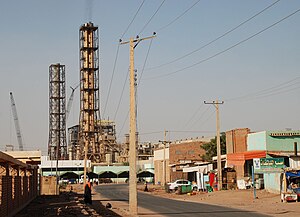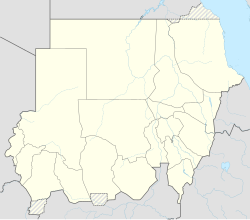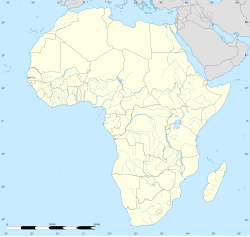Khartoum North
This article has multiple issues. Please help improve it or discuss these issues on the talk page. (Learn how and when to remove these messages)
|
Khartoum North
الخرطوم بحري | |
|---|---|
Neighborhood | |
 Industrial area of Khartoum North | |
| Nickname: Bahri | |
| Coordinates: 15°39′00″N 32°32′45″E / 15.65000°N 32.54583°E | |
| Country | |
| State | Khartoum |
| Population (2008) | |
• Total | 1,012,211 |
| Time zone | UTC+2 (Central Africa Time) |
Khartoum North, or Khartoum Bahri (Arabic: الخرطوم بحري, romanized: al-Kharṭūm Baḥrī), is a city in Khartoum State, lying to the north of Khartoum city, the capital of Sudan. It has a population of 1,012,211 people, making it the third-largest city proper in Sudan, behind the neighbouring cities of Omdurman and Khartoum.
Geography
It is located on the north bank of the Blue Nile, and the east bank of the River Nile, near the confluence of the Blue Nile with the White. Until 2023, the Shambat Bridge connected it with Omdurman to its west. Another major bridge links it with Khartoum to the south.
It was part of a three-city agglomeration (with Khartoum proper and Omdurman) with a combined population of 4,272,728 in 2008.
Demographics

| Year | Population[1] |
|---|---|
| 1956 | 39,100 |
| 1973 | 150,989 |
| 1983 | 341,155 |
| 1993 | 700,887 |
| 2008 Census | 1,012,211 |
History
The original settlement was the largest in the area of the Nile confluence before the Egyptians established Khartoum as their military garrison and administrative centre in the 1820s.[2] It was eclipsed by Egyptian Khartoum, its Mahdist replacement Omdurman, and the British refounding of Khartoum following their reconquest of the country in 1898. However, Khartoum North began to grow again as the southern terminus of the Sudan Military Railroad, completed in 1899.[2] The Blue Nile was bridged in 1910, and the line extended to Sennar, but Khartoum North continued to serve as the central railroad station and yard.
On August 20, 1998, the Al-Shifa pharmaceutical factory was destroyed by a cruise missile after the United States accused the factory of making VX (nerve agent) for al-Qaeda.[3][4][5]
Economy
The area is the industrial centre of the region and the country. It contains dockyards, marine and rail workshops, and sawmills. Khartoum North trades in cotton, grains, fruit, and livestock; industries include tanning, brewing, brickmaking, textile weaving, and food processing. After 2000, chemical plants supplying household products to the rest of the country were built there. [citation needed]
A wealthy suburb emerged towards the eastern part of the neighbourhood, along the Blue Nile.
Neighbourhoods
Khartoum North has many neighbourhoods, including:
- Alamlaak
- Kober
- Kafouri
- Bahri Industrial Area
- Al Haj Yousif
- Al Sababi
- Al Dnagla North
- Al Dnagla South
- Hilat Hamad
- Hilat Khojali
- Hilat Koko
- Alshabia North
- Alshabia South
- Almazad
- Almugtaribin
- Almerghania
- Alsafia
- Shambat
- Khoglab
- Alqadisia
- السامراب
- الدروشاب
- حطاب
- دردوق
- الحلفايه
- العزبه
- الكدرو
- ابو حليمه
- الجيلي
- نبته
- الفكي هاشم
Infrastructure

Bridges
The following bridges cross the Blue Nile and connect Khartoum North to Khartoum:
- Mac Nimir Bridge
- Blue Nile Road and Railway Bridge
- Cooper Bridge
- Al Mansheiya Bridge
- Shambat Bridge crosses the Nile and connects the neighborhood to Omdurman, it was destroyed in 2023.
Education
- University of Bahri
- Alzaiem Alazhari University
- Al-Salama College of Science and Technology

References
- ^ "Bevollkerung Statistik". Archived from the original on September 30, 2007.
- ^ a b "Chisholm, Hugh, ed. (1911). . Encyclopædia Britannica. Vol. 15 (11th ed.). Cambridge University Press. p. 773.
- ^ Astill, James (October 2, 2001). "Strike one". The Guardian. London.
- ^ "US Destruction of Al Shifa Factory 14th Anniversary". Sudanese embassy in Washington, DC. Archived from the original on 2013-01-17.
- ^ Peterson, Scott. "Sudanese factory destroyed by US now a shrine". Christian Science Monitor.


